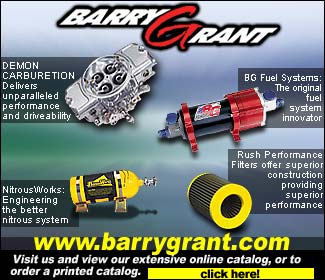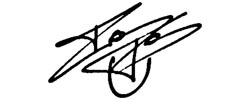|

Regardless, the bottom line really is that
I want to continue seeing 300-plus-mph passes.
To me, that's the magic number and without
it, Top Fuel just wouldn't be Top Fuel anymore.
And I'd bet that's the opinion of the casual
fan in the stands, too. I'm convinced most
fans couldn't care less about seeing a 4.48-second
pass versus a 4.98-second pass—but they
do pay attention to the speed. Think about
it. When some guy who comes out just once a
year to see the visiting NHRA or IHRA nitro
spectacle goes back to work on Monday, what's
he gonna' tell his buddies: "They were
running mid-4s," or, "They were going
over 300 miles an hour!"? It's all about
the speed, man. That's what sets Top Fuel and
Fuel Coupes apart, they are the fastest racecars
going—bar none—and that's what
people remember.
But I don't think they have to go faster and
faster. With both classes now making 320-mph
runs seem almost routine, and 330-mph passes
no longer uncommon, I think they're going fast
enough and the sanctioning bodies have to do
whatever it takes to establish and enforce
a speed limit over the quarter-mile distance.
I know, I know, I can already hear
ADVERTISEMENT
 |
howls of
outrage from the purists out there, but that
was the opinion of many, many NASCAR fans,
too, when that organization arbitrarily decided
back in 1987 to make 200 mph its never-exceed
speed—regardless of which track they
ran on or what technology came down the pike.
And it hasn't seemed to hurt their popularity.
So far in drag racing, though, the powers
that be have historically reacted with rule
changes to lower speeds temporarily after an
accident or series of accidents, only to have
the race teams quickly recover the lost ground
and go even quicker and faster in short order.
That cycle has to stop somewhere and NHRA/IHRA
officials are the only ones who can make that
call—and make it stick. They have to
mandate rules that can quickly be adapted when
teams start approaching their never-exceed
speed. And be willing to enforce that speed
limit over the long haul.
Now, I don't pretend to know what rules should
be made. I've heard all the talk about nitro
percentages, wing sizes, wing angles, blower
overdrives, etc., but I certainly don't have
the engineering or racing background to seriously
make suggestions on what to change. I have
faith, however, that there are people in places
of power with the know how to get this done.
Yes, it would mean the end of national record
setting, but again, no one seems miffed that
Bill Elliott is still the fastest stock car
driver 17 years later. Why should drag racing's
fans be any different? Crew chiefs would still
be concentrating on getting the most out of
their combinations to go as fast as possible—the
rules just wouldn't allow them to be at the
limit. It works at Daytona and Talladega qualifying,
so it should work at Pomona or Englishtown,
too. Plus, establishing a speed limit would
allow Goodyear and perhaps other parts suppliers
to better research and develop products they
know will stand up to the punishment of nitro
racing. Every car down the track would no longer
have to be a rolling testbed. If you give them
a target they can count on not to move at the
next race, I'm confident they can hit it.
Another option, of course, would be to reduce
the racing distance to an eighth mile, return
to 98% nitro, leave the wings as they are,
and give basically free rein to the teams in
the engine and clutch departments. That would
permit a whole new slew of records to be set
and would effectively reduce the racing speeds
to a much more manageable level. However, setting
and enforcing a speed limit (and I advocate
setting it at or higher than the fastest speed
so far attained), would ensure the 1320 would
continue to be the "normal" playing
field and drag racing would continue in the
form we all recognize and love. 

Previous
Story |
Tocher
Talks — 8/9/04
Making the case for Outlaw 10.5 sponsorship |
|
